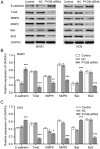PYGB siRNA inhibits the cell proliferation of human osteosarcoma cell lines
- PMID: 29845265
- PMCID: PMC6059700
- DOI: 10.3892/mmr.2018.9022
PYGB siRNA inhibits the cell proliferation of human osteosarcoma cell lines
Abstract
Osteosarcoma is the most common malignant bone carcinoma that primarily occurs between childhood to adolescence. It was suggested by recent research that the Brain type glycogen phosphorylase (PYGB) gene may serve an important role in various types of cancer. In the present study, the PYGB gene was knocked down in order to evaluate the cell viability, invasion and migration of the human osteosarcoma cell lines MG63 and HOS. The expression levels of PYGB in osteosarcoma and bone cyst tissue samples, as well as in the osteosarcoma cell lines were identified using reverse transcription‑quantitative polymerase chain reaction and western blot assay. Subsequently, a Cell Counting kit 8 assay was employed to evaluate cell proliferation. Cell apoptosis rate and cell cycle distribution were measured by flow cytometry. In addition, cell invasion and migration were evaluated through a Transwell assay. The expression levels of the cell apoptosis and tumor metastasis associated proteins B‑cell lymphoma 2 (Bcl‑2), Bcl‑2‑associated X protein, E‑cadherin, Twist, matrix metalloproteinase (MMP)‑9 and MMP2 were measured via western blotting. PYGB exhibited a higher expression level in the osteosarcoma tissue samples, particularly in the human osteosarcoma cell lines MG63 and HOS. Knockdown of PYGB resulted in a decline in cell proliferation, invasion and migration, which was coupled with induced cell apoptosis and cell cycle arrest in MG63 and HOS cells. Furthermore, alterations in the expression of apoptosis and metastasis associated proteins indicated that small interfering (si)PYGB may have regulated cell viability by targeting the Bcl/Caspase and cyclin dependent kinase (CDK)‑1 signaling pathway. In conclusion, PYGB siRNA exerted an inhibitory effect on the cell viability of the human osteosarcoma cells MG63 and HOS by blocking the Caspase/Bcl and CDK1 signaling pathway, highlighting novel potential therapeutic methods for treating osteosarcoma.
Figures





Similar articles
-
Silencing of PYGB suppresses growth and promotes the apoptosis of prostate cancer cells via the NF‑κB/Nrf2 signaling pathway.Mol Med Rep. 2018 Oct;18(4):3800-3808. doi: 10.3892/mmr.2018.9388. Epub 2018 Aug 14. Mol Med Rep. 2018. PMID: 30106110 Free PMC article.
-
Knockdown of autophagy-related protein 6, Beclin-1, decreases cell growth, invasion, and metastasis and has a positive effect on chemotherapy-induced cytotoxicity in osteosarcoma cells.Tumour Biol. 2015 Apr;36(4):2531-9. doi: 10.1007/s13277-014-2868-y. Epub 2014 Nov 27. Tumour Biol. 2015. PMID: 25427639
-
Establishment and characterization of human osteosarcoma cells resistant to pyropheophorbide-α methyl ester-mediated photodynamic therapy.Int J Oncol. 2017 Nov;51(5):1427-1438. doi: 10.3892/ijo.2017.4136. Epub 2017 Sep 27. Int J Oncol. 2017. PMID: 29048645 Free PMC article.
-
Effects of SOST Gene Silencing on Proliferation, Apoptosis, Invasion, and Migration of Human Osteosarcoma Cells Through the Wnt/β-Catenin Signaling Pathway.Calcif Tissue Int. 2017 Jun;100(6):551-564. doi: 10.1007/s00223-016-0231-6. Epub 2017 Feb 28. Calcif Tissue Int. 2017. PMID: 28246931
-
Homeodomain-containing gene 10 inhibits cell apoptosis and promotes cell invasion and migration in osteosarcoma cell lines.Tumour Biol. 2017 May;39(5):1010428317697566. doi: 10.1177/1010428317697566. Tumour Biol. 2017. PMID: 28474998
Cited by
-
PYGB Promoted Tumor Progression by Regulating Wnt/β-Catenin Pathway in Gastric Cancer.Technol Cancer Res Treat. 2020 Jan-Dec;19:1533033820926592. doi: 10.1177/1533033820926592. Technol Cancer Res Treat. 2020. PMID: 32462986 Free PMC article.
-
Bioinformatics analysis of differentially expressed genes and identification of an miRNA-mRNA network associated with entorhinal cortex and hippocampus in Alzheimer's disease.Hereditas. 2021 Jul 9;158(1):25. doi: 10.1186/s41065-021-00190-0. Hereditas. 2021. PMID: 34243818 Free PMC article.
-
Revisiting Glycogen in Cancer: A Conspicuous and Targetable Enabler of Malignant Transformation.Front Oncol. 2020 Oct 30;10:592455. doi: 10.3389/fonc.2020.592455. eCollection 2020. Front Oncol. 2020. PMID: 33224887 Free PMC article. Review.
-
Brain-Type Glycogen Phosphorylase (PYGB) in the Pathologies of Diseases: A Systematic Review.Cells. 2024 Feb 5;13(3):289. doi: 10.3390/cells13030289. Cells. 2024. PMID: 38334681 Free PMC article.
-
Glycogen Phosphorylase B Is Regulated by miR101-3p and Promotes Hepatocellular Carcinoma Tumorigenesis.Front Cell Dev Biol. 2020 Nov 25;8:566494. doi: 10.3389/fcell.2020.566494. eCollection 2020. Front Cell Dev Biol. 2020. PMID: 33324633 Free PMC article.
References
-
- Bacci G, Ferrari C, Longhi A, Ferrari S, Forni C, Bacchini P, Palmerini E, Briccoli A, Pignotti E, Balladelli A, Picci P. Second malignant neoplasm in patients with osteosarcoma of the extremities treated with adjuvant and neoadjuvant chemotherapy. J Pediatr Hematol Oncol. 2006;28:774–780. doi: 10.1097/01.mph.0000243664.02174.73. - DOI - PubMed
MeSH terms
Substances
LinkOut - more resources
Full Text Sources
Other Literature Sources
Miscellaneous

